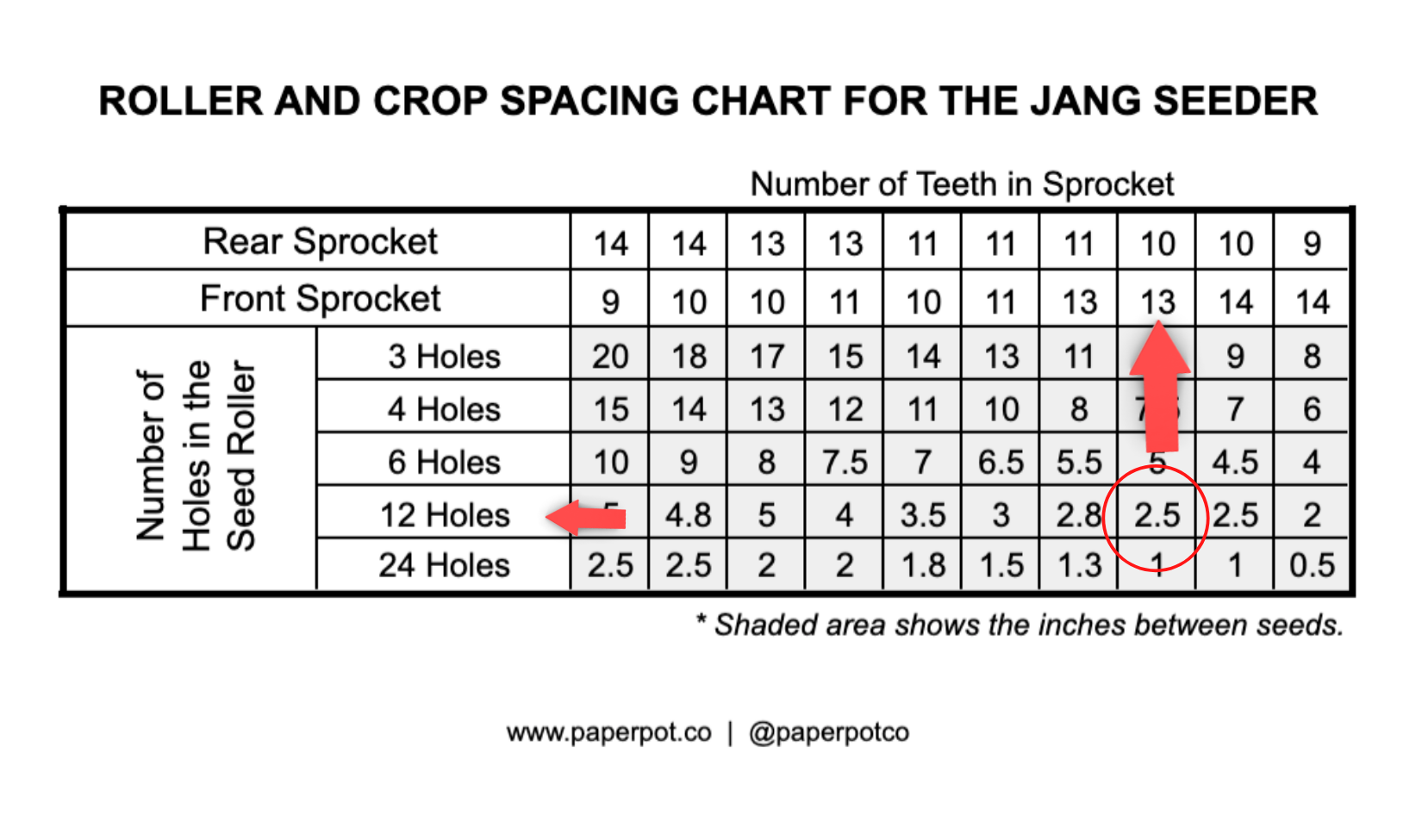Which Jang Seed Roller to Use
Choosing a roller can seem confusing at first, but it’s actually pretty simple, and on this page we’ll show you how.
First, we need to talk about terminology.
But if you want to go down to business, feel free to skip down to our chart and select a roller.
JANG SEED ROLLER BASICS
Each Jang roller has a letter-number code on it, for example, “A-6”:
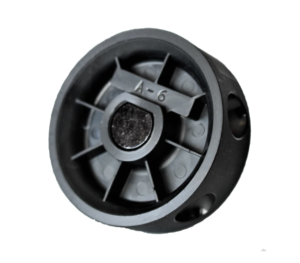
For now, ignore the letter “A” and pay attention to the number “6”. The “6” represents how many holes are in the roller. This is one of two factors that determine seed spacing.
The Jang Seeder also utilizes two interchangeable sprockets, a front and a rear, to control the rate at which seeds are dropped. These sprockets are the other factor that controls seed spacing.
The letter on your roller (or letter combination), on the other hand, designates the size of the hole on the roller. The size of the hole on the roller needs to correspond to the size of your seed. Consult the Jang Roller Hole Size Chart to find the correct hole size (letter) for your seed.
HOW DO I SELECT THE RIGHT JANG SEED ROLLER?
First, decide how far apart you want your seeds in the row.
For example, let’s say you want to plant carrots, and you want each seed spaced 2.5 inches apart.
In the Roller and Crop Spacing Chart below, look for 2.5 in the shaded area. The shaded area represents different in-row spacings for seeds.
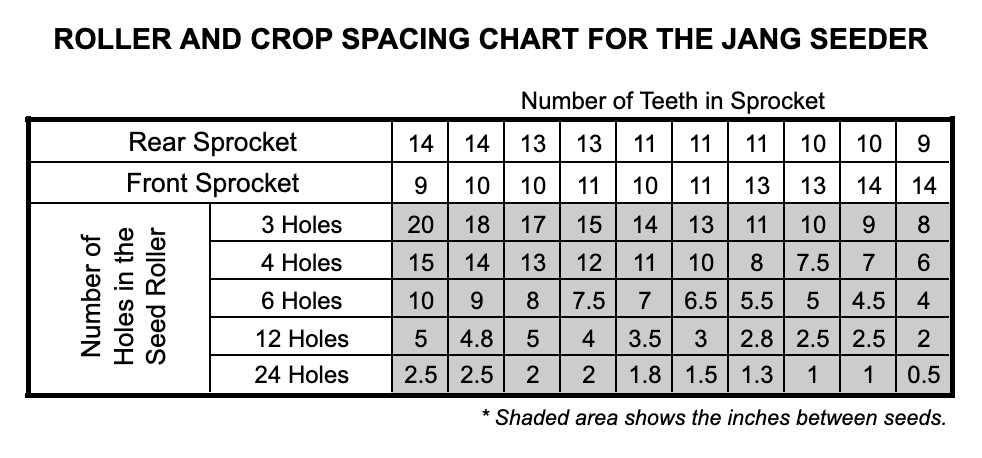
This chart is also mounted directly on your Jang Seeder for easy reference.
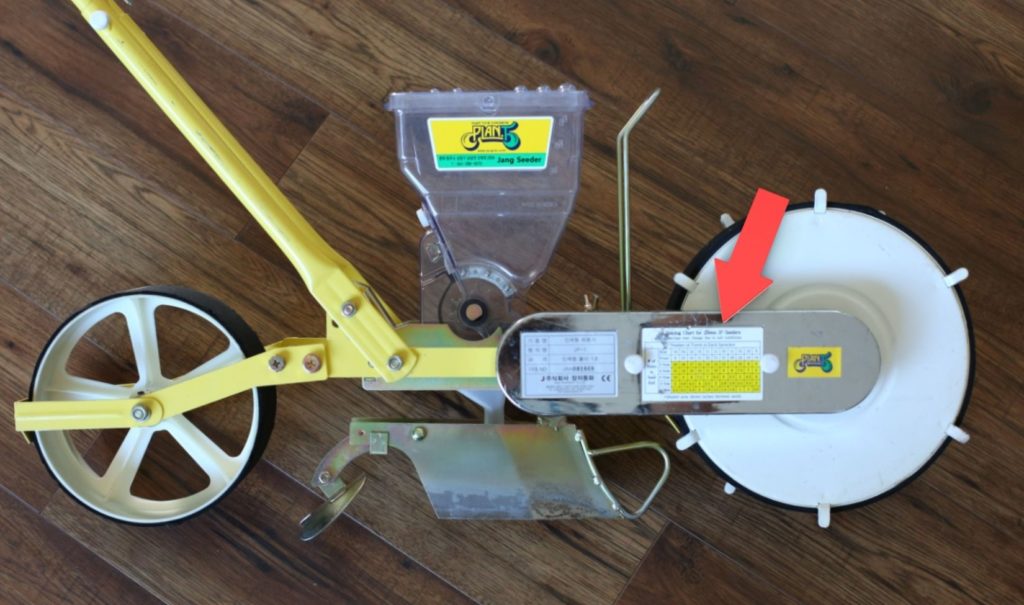
Found the “2.5”?
The “2.5” represents 2.5 inches between each seed in the soil at the given seeder configuration.
Looking to the left in the same row as the “2.5” will give you the number of holes needed in the roller to achieve that spacing. Looking up in the same column will give you the sprocket configuration needed.
For example, if you want 2.5-inch spacing (as circled in red in the chart below), use a 24-hole roller with a sprocket combination of 14 on the rear sprocket and 9 on the front sprocket.
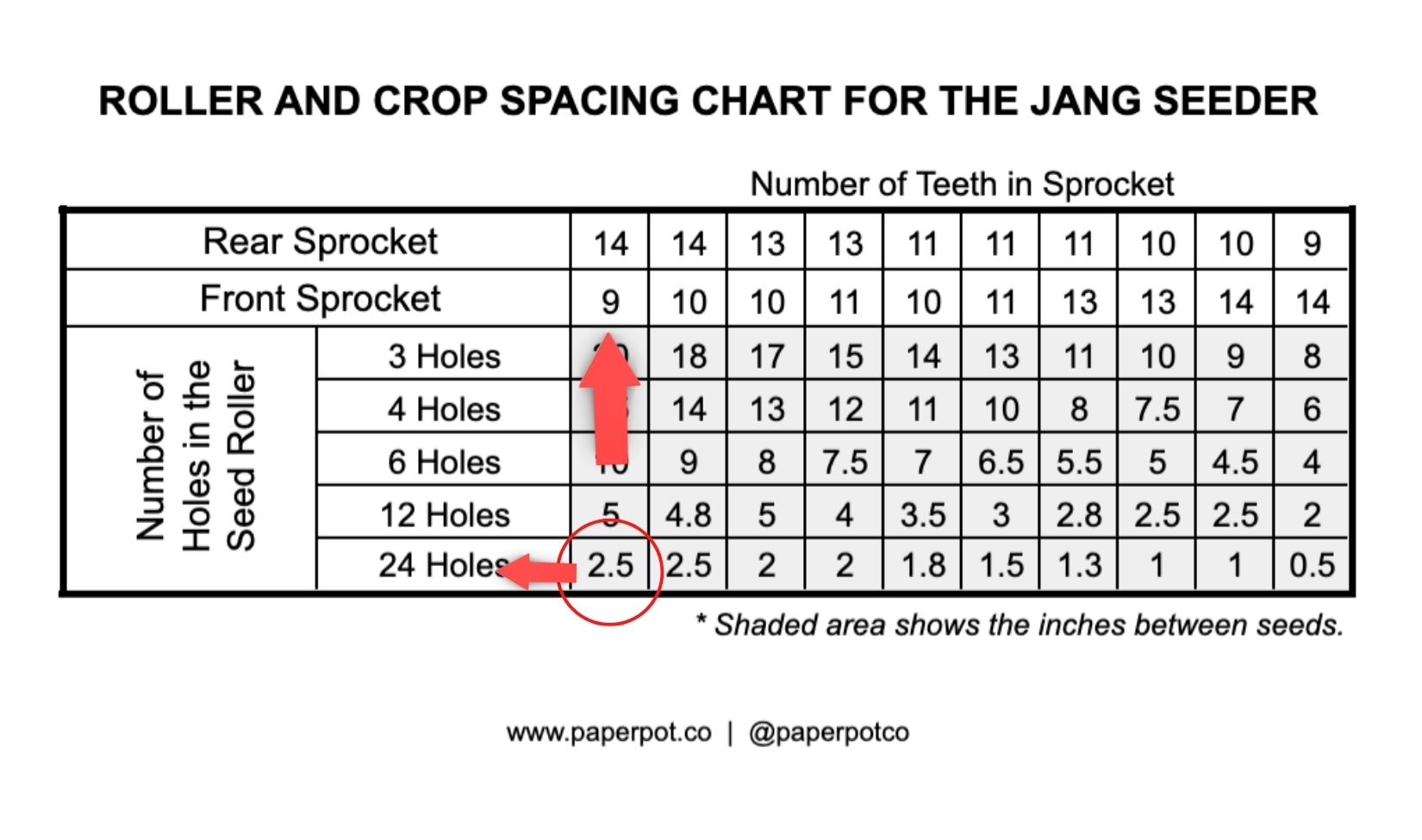
That said, there are other ways to achieve 2.5-inch spacing. For example, you could use a 12-hole roller with the rear sprocket set at 10 and the front sprocket set at 13. This option is highlighted in the chart below.
You want to select the hole/sprocket combination that best fits your needs.
Think about what type of seed spacing range you want to have. For example, a 24-hole roller will only allow seed spacings between 0.5 and 2.5 inches whereas a 12-hole roller will allow seed spacings anywhere between 2 and 5 inches.
Also, consider what crops you are using the roller for. A 12-hole roller might allow you to seed one crop at 2 inches and another at 5 inches. This saves you the trouble of having to purchase a separate roller for each spacing.
Ideally, you can select the fewest rollers possible to seed a variety of different crops.
If you have trouble deciding, consult our Jang Seeding Chart.
Once you have found the optimum spacing, choose the hole size.
Jang rollers work by allowing seeds to drop into a hole in the roller. The roller then spins, dropping the seed into a planting tube.
When choosing a hole size (hole diameter) you want to match the hole size in the roller to the size of your seed. The larger the hole, the bigger the seed – or the higher the number of small seeds – can fit into a given hole.
You can measure your seeds using the measuring gauge that is built into the Jang hopper lid. Or just use a ruler. Be sure to measure several seeds to account for seed size variation and then to average them out.
If you notice a large size variation, size your roller for the largest seed size.
The chart below allows you to pick the best roller based on hole size and hole depth. When you have two choices for hole depth for a given hole size, choose the larger hole depth.
For example, let’s say you want to plant okra. You measure your seeds and find that most seed sizes fall between 7 and 9 mm.
Given that, you would choose a “G” roller using the chart below.
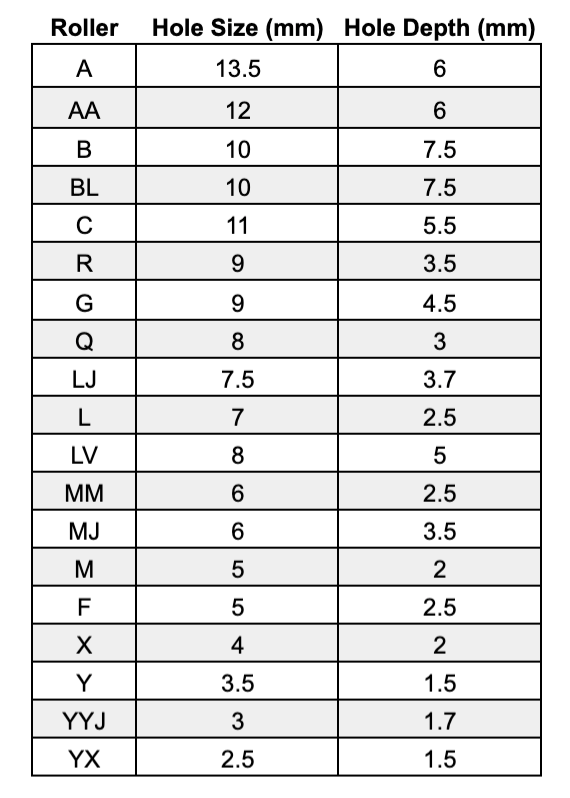
If you have trouble deciding, consult our Jang Seeding Chart, which provides recommendations from professional market gardener Erich Schultz for different types of seeds.
What about sprockets? Do I have to buy those, too?
No. A variety of sprockets are included with your Jang JP1 or JP5 seeder. They do not need to be purchased separately.
Each sprocket is labeled from 9 to 14, each number corresponding to the number of teeth in the sprocket. Changing the sprockets is simple and can be done in just a few minutes without tools.
JANG JP1 & JP5 SEEDING CHART
Start with proven roller and sprocket combinations.
Below is a chart developed by professional market gardener Erich Schultz of Steadfast Farm showing the Jang rollers and sprocket configurations needed to plant the most common market garden crops and homestead vegetables with the Jang JP1 or JP5.
We have also included the recommended number of rows of each crop per 30-inch bed. We suggest using this chart as a starting point and then adjusting based on local conditions.
PURCHASE JANG SEED ROLLERS HERE
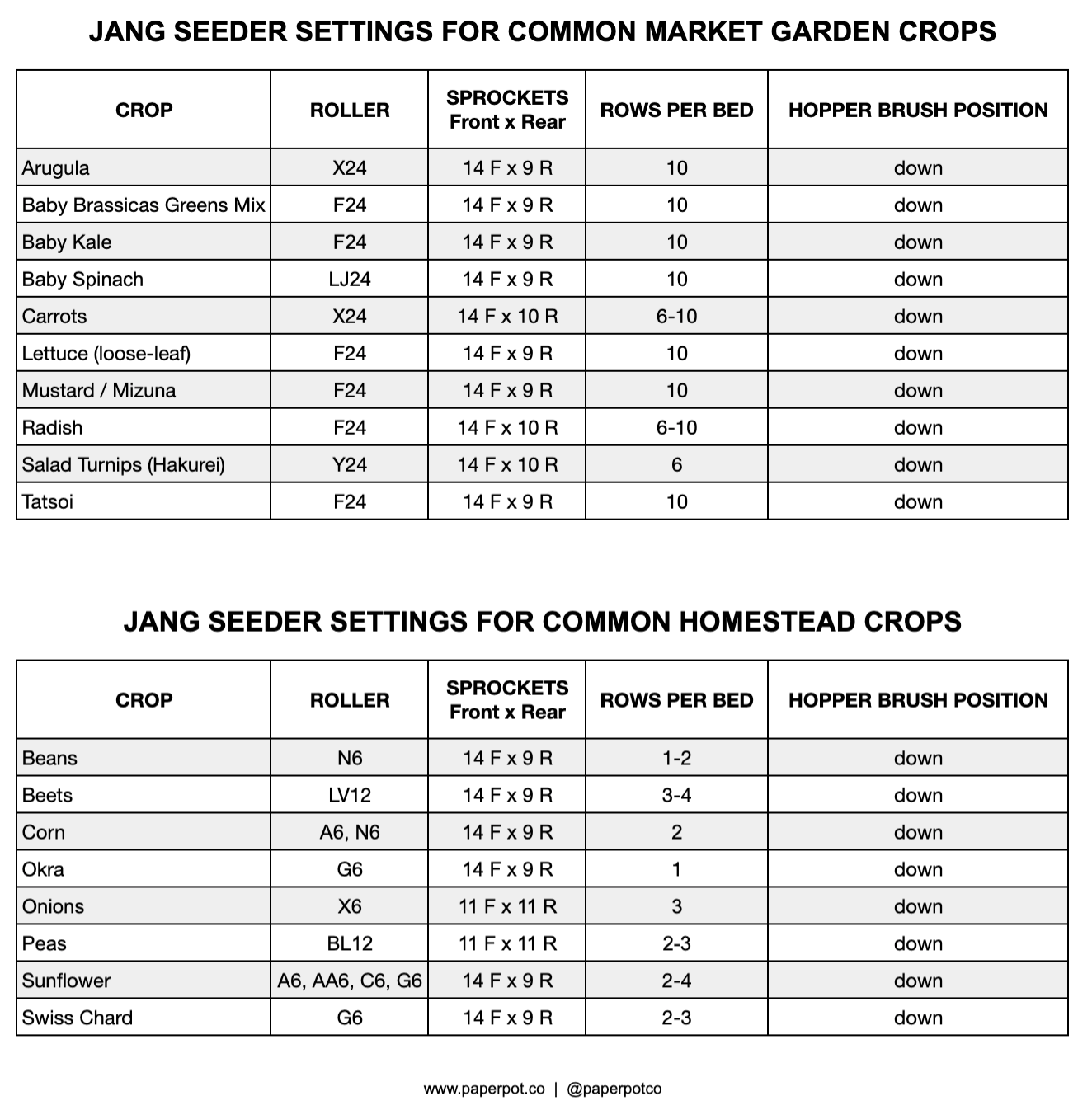
The seeding chart was developed in partnership with Erich Shultz of Steadfast Farm.
Download the Paperpot Co Jang Seeding Chart
What about the hopper brush? Do I have to ever have to adjust that?
We recommend always starting with the brush in the down position. If needed, you can raise the brush up. This will allow a larger seed to pass under it. But take note: raising the brush too high can result in too many seeds being dropped through.
The brush can be adjusted by removing the hopper and loosening the wingnut that holds the brush in place. Once loosened, the brush can easily be moved up or down to the desired level.
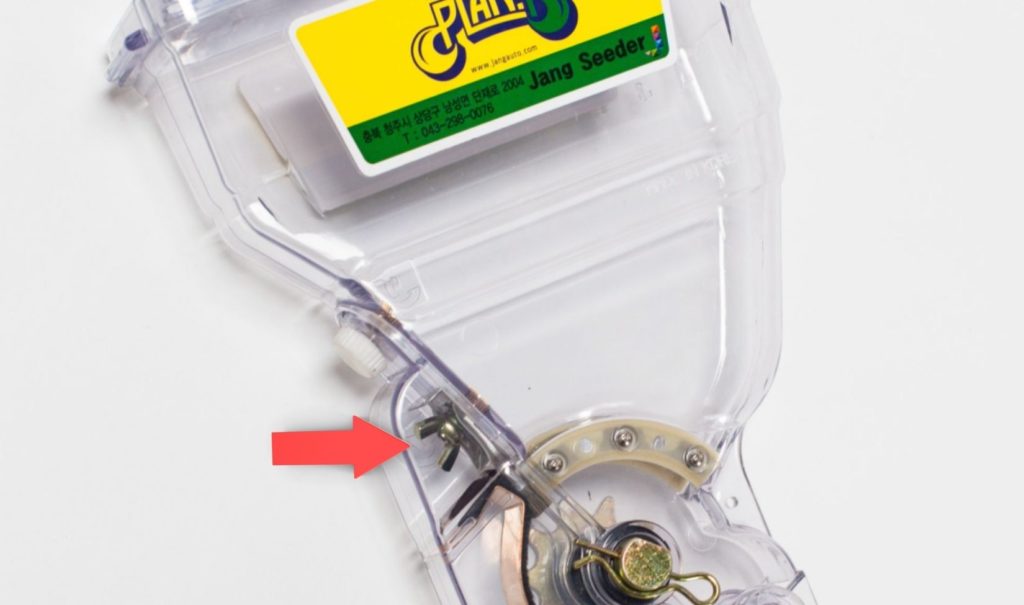
Do a quick test inside before you go out to the field.
To ensure that your Jang roller and seed match up, remove the hopper from the seeder and place a handful of seeds in the hopper. Place a small bowl under the seeding tube to collect the ejected seed.
Manually turn the hopper sprocket to ensure that seeds are being dropped evenly and that each roller hole is receiving a seed. Carefully watch for multiple drops or holes being skipped. If everything checks out, then you’re ready to head out into the field and get seeding.
I can’t find a seed roller that fits. Do you sell blanks?
Yes! We sell blank rollers without holes, allowing you to drill out your own custom roller. If you have any questions about selecting a roller, please feel free to reach out to us at hello@paperpot.co or call us at 877.850.1555.
PURCHASE JANG SEED ROLLERS HERE
Interested in purchasing a Jang JP1 or Jang JP5? Click here.

